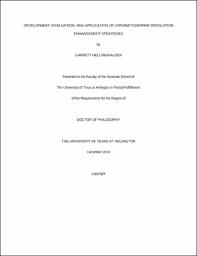
ATTENTION: The works hosted here are being migrated to a new repository that will consolidate resources, improve discoverability, and better show UTA's research impact on the global community. We will update authors as the migration progresses. Please see MavMatrix for more information.
Show simple item record
| dc.contributor.advisor | Armstrong, Daniel W. | |
| dc.creator | Hellinghausen, Garrett | |
| dc.date.accessioned | 2020-01-10T18:49:39Z | |
| dc.date.available | 2020-01-10T18:49:39Z | |
| dc.date.created | 2019-12 | |
| dc.date.issued | 2019-11-15 | |
| dc.date.submitted | December 2019 | |
| dc.identifier.uri | http://hdl.handle.net/10106/28840 | |
| dc.description.abstract | With the emergence of advanced separation technologies, like high-efficiency stationary phases bonded with superficially porous particles, or sub-2 μm fully porous particles, faster and more effective methodologies are possible for liquid chromatographic analyses. Such advanced approaches can be easily applied to achiral separations but require more extensive optimization for chiral separations. Chiral molecules are subjected to extensive characterization of their enantiomeric pharmacological properties due to requirements of the Food and Drug Administration. Herein, fundamental chiral method development strategies are thoroughly discussed for hundreds of small molecules using conventional and newly synthesized chiral selectors bonded to high-efficiency supports. In these strategies the principle of complementary behavior is utilized, in which a separation can be obtained just by switching the chiral selector. These methodologies were developed with cyclofructans, cyclodextrins, and macrocyclic glycopeptides as chiral selectors. A variety of organic modifiers and additives were investigated for each selector to determine the best screening protocol, which is often the optimal separation condition. Solvents compatible with mass spectrometry were primarily used to promote sensitive biological enantiomeric analysis. Utilizing these strategies led to the development of modified selectors to target separations of specific analytes, like nicotine. Applications were reported, including the determination of high levels of an unnatural nicotine enantiomer in commercial products that has not been deemed safe.
Despite the increased efficiency from small, superficially porous particles and high selectivity from novel selectors, chromatographic peak overlap can still be observed in some cases. Quantitation becomes more inaccurate as chromatographic resolution decreases, especially with asymmetric peaks because peak integration becomes ambiguous. Conventional strategies to increase chromatographic resolution focus on the use of high efficiency supports bonded to novel selectors analyzed with high resolution instruments. Instead, mathematical approaches were applied after data collection or post-signal acquisition. Signal processing is well established in optical and nuclear magnetic resonance spectroscopy. Herein, these principles have been applied to chromatography data. While there is a focus of using these techniques for fast ultra-high-pressure liquid chromatographic analysis, they can be applied to any chromatographic data (i.e., gas, liquid, supercritical fluid, capillary electrophoresis, etc.). Mathematical approaches using derivatives or power law can enhance resolution of overlapping peaks, usually by reducing peak widths and reduce background noise. These techniques maintain the retention time and area of each peak that is needed for accurate quantitation. It has been shown that there is minimal error (< 1 %) in processed peak areas when the overlapping pair is separated enough to distinguish the peaks’ maximum (a resolution = ~0.8). Derivatives and power law are also useful for impurity and peak purity analysis. Once automated and integrated within chromatography data software, these techniques will revolutionize the chromatography field in a way that is similar to previous spectroscopy advancements. The advantages and limitations of each technique have been determined to facilitate the appropriate use of post-acquisition signal processing resolution enhancement strategies. | |
| dc.format.mimetype | application/pdf | |
| dc.language.iso | en_US | |
| dc.subject | Enantiomeric separation | |
| dc.subject | Superficially porous particles | |
| dc.subject | Signal processing | |
| dc.subject | Power law | |
| dc.subject | Derivatives | |
| dc.title | DEVELOPMENT, EVALUATION, AND APPLICATION OF CHROMATOGRAPHIC RESOLUTION ENHANCEMENT STRATEGIES | |
| dc.type | Thesis | |
| dc.degree.department | Chemistry and Biochemistry | |
| dc.degree.name | Doctor of Philosophy in Chemistry | |
| dc.date.updated | 2020-01-10T18:49:55Z | |
| thesis.degree.department | Chemistry and Biochemistry | |
| thesis.degree.grantor | The University of Texas at Arlington | |
| thesis.degree.level | Doctoral | |
| thesis.degree.name | Doctor of Philosophy in Chemistry | |
| dc.type.material | text | |
| dc.creator.orcid | 0000-0002-5427-327X | |
Files in this item
- Name:
- HELLINGHAUSEN-DISSERTATION-2019.pdf
- Size:
- 7.729Mb
- Format:
- PDF
This item appears in the following Collection(s)
Show simple item record


